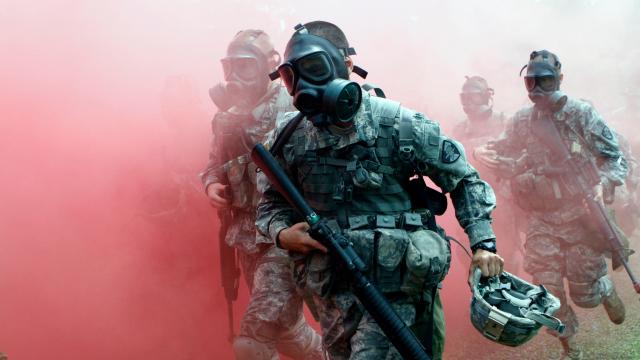Last week, the United States and its allies France and the UK fired 105 missiles – most of them Tomahawks – at Syrian targets in an attempt to prevent future chemical attacks in the Syrian Civil War. But what are the alleged chemical weapons being used? And what exactly do they do to people? Here’s what you need to know.
Photo: West Point
Sarin
Sarin is an odourless and colourless liquid that is an extremely potent nerve agent. It’s often released in the air as a vapour spray or aerosol in a target area.
Once a lethal dose of the vapour is inhaled, it causes lung muscle paralysis, and, depending on the amount inhaled, death can occur within one to 10 minutes. Even those who do not inhale a lethal dose of the chemical, or absorb some through the skin, can suffer permanent neurological damage.
The production and stockpiling of sarin was outlawed in 1997 by the United Nations’ Chemical Weapons Convention of 1993, and it is now considered a Schedule 1 substance. The US stopped production of sarin as far back as 1957.
Still, the substance has been used by a Japanese cult to attack civilians on the train, as well as by Iraqi insurgents, and it’s still being used in the ongoing Syrian Civil War.
Chlorine Gas
Chlorine gas, also known as bertholite, might sound similar to the stuff that keeps swimming pools clean, but it most definitely is not. The substance is a remnant of the deadly chemical weapons used during World War I.
Once the gas is released in the air, victims smell something akin to pepper and pineapple, then are overwhelmed with a metallic taste in the mouth. Then comes stinging in the throat and chest as it attacks the respiratory system, eyes and skin. Once chlorine gas has reached the lungs, it reacts with moisture to form hydrochloric acid, essentially burning from the inside out.
The gas is arguably less deadly than sarin or mustard gas because it can be filtered out with gas masks, but not many civilians have them on hand. It has been used in the Iraq War in 2007, against Kurdish forces in Iraq in 2015, and the Syrian government has allegedly used it in the form of barrel bombs and rockets as recently as January and February of this year.
Mustard Gas
Like chlorine gas, mustard gas (or sulphur mustard) is a chemical weapon that originated with WWI trench warfare.
The substance is a cytotoxic and vesicant chemical agent, so it causes blistering of both the skin and lungs of its victims. The chemical is also mutagenic and carcinogenic, meaning it can cause genetic mutations as well as cancer. Victims rarely suffer immediate symptoms, so many are unknowingly exposed to high dosages and may feel completely normal at first. And the substance easily penetrates common clothing fabrics such as wool and cotton, so it’s hard to protect the skin.
Once exposed, victims smell an odour similar to mustard plants, garlic or horseradish. Soon, they begin to feel intense itching and skin irritation over the next 24 hours. Gradually, those irritated areas become a chemical burn and victims develop blisters filled with a yellow fluid (here’s the least graphic photo I could find). These burns can range anywhere from first-degree burns to deadly third-degree burns. If one’s eyes are exposed during an attack, blindness is also a possibility.
[referenced url=”https://www.lifehacker.com.au/2017/11/what-is-an-emp-bomb/” thumb=”https://i.kinja-img.com/gawker-media/image/upload/t_ku-large/ebc86tv6fj5mdsqifwjq.jpg” title=”What Is An EMP Bomb?” excerpt=”During a hearing on October 12, experts warned the US House of Representatives that an EMP bomb, likely from North Korea, could kill as many as 90 per cent of all Americans within a year. But what is an EMP bomb? And could such a weapon really be that devastating?”]
Technically, mustard gas isn’t even a gas; it’s a fine mist of liquid droplets dispensed from a device (be it artillery shells, bombs, missiles, or spraying from planes overhead), much like sarin. These pure sulphur mustards are actually colourless liquids, but when used in chemical warfare, the “gas” appears to be a nauseating yellow-brown – hence the name.
Mustard gas saw most of its use in the first World War, but has since been used during attacks in the UK, Spain, France, China, and all over the Middle East, including Syria’s Civil War.
Agent 15
Agent 15, or 3-Quinuclidinyl benzilate (NATO code “BZ”), is an odourless, non-lethal “psycho-chemical” or hallucinogenic nerve agent used by militaries to incapacitate targets.
“Agent 15” is the name for the supposed Iraqi military brand of the substance. Once inhaled or ingested, it messes with the central nervous system, causing abrupt changes in mental status and delirium. Overdose of the substance can be deadly. The disturbing film Jacob’s Ladder is loosely based on the longterm effects of the chemical agent.
In recent years, Syrian contacts have suggested that Agent 15 was used in an attack in Homs, but there hasn’t been enough evidence to confirm. Agent 15 was also allegedly used in an attack on Ghouta in 2013.
VX Agent
This synthetic chemical compound is considered to be the deadliest nerve agent known to man, but is extremely rare in its use.
VX agent, or “venomous agent x,” is extremely toxic and kills very quickly. Once administered, either via direct spray or the poisoning of food or water, victims experience violent convulsions, followed by unconsciousness, paralysis and finally death. The best way to describe the way it works is a “pesticide for people”, gradually tiring and suffocating the body.
The substance is completely odourless and tasteless, and resembles an oily, yellowish-brown liquid. Perhaps what’s worst about the substance is that it evaporates extremely slowly, so it persists in the environment it was used.
Notable uses of the substance is small – it’s more of a secret assassination weapon than a mass casualty weapon – but it was most recently used to assassinate Kim Jong Nam, the half-brother of North Korea’s leader Kim Jong Un.

Comments